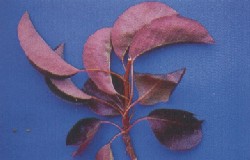|

German Version
Site map
FAIR 3889
Virus diseases
Phytoplasma diseases
AP
ESFY
PD
Pathogen collection
Pathogen detection
Pathogen elimination
Contact us
Related Sites
|
Pear Decline
(PD)
 The decline of pear trees characterized by symptoms like weak growth and
small, pale leaves that later turn reddish, has amongst many causes like
asphyxia, malnutrition, drought or incompatibility also often an association
with infectious micoorganisms of the mollicutes family.
The decline of pear trees characterized by symptoms like weak growth and
small, pale leaves that later turn reddish, has amongst many causes like
asphyxia, malnutrition, drought or incompatibility also often an association
with infectious micoorganisms of the mollicutes family.
During the vegatative season, pear decline phytoplasmas multiply cyclically
and sometimes very rapidly in sieve tubes.
In grafts on susceptible rootstocks like Pyrus serotina, Pyrus
ussuriensis and some seedling of Pyrus communis, the mollicutes
develop abundantly in spring and can induce an accumulation of callose and/or
a production of toxins. By lifting the bark it is possible to observe dark
strains like burnt patches, particularly at the graft union. This partial
necrosis of phloem extends over the most sensitive tree part.
Some plants wilt within a few months, but the majority can survive for many
years with a decreased vegetation and fructification, depending on weather
conditions. Diseased trees are vulnerable to extreme conditions.
|



